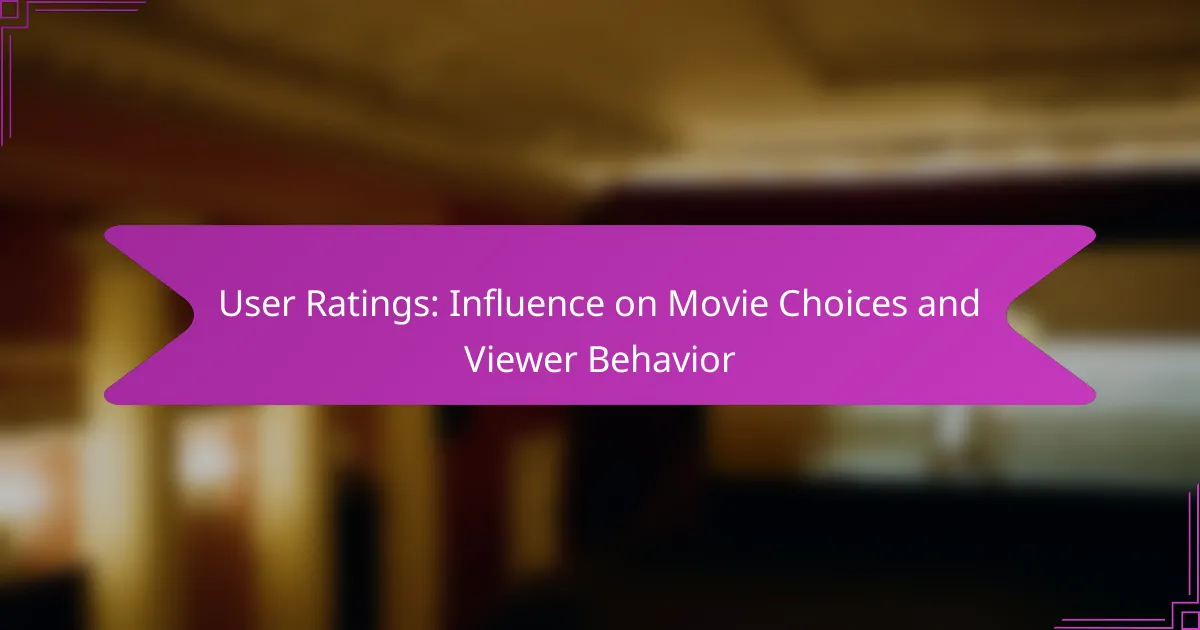User ratings play a crucial role in shaping movie choices and viewer behavior, as they directly influence perceptions and preferences. High ratings can attract more viewers, while low ratings may discourage potential audiences from engaging with a film. By examining the factors that affect these ratings, such as demographics and social media trends, we can better understand their impact on viewing habits.

How do user ratings influence movie choices?
User ratings significantly impact movie choices by shaping viewer perceptions and preferences. High ratings often lead to increased interest and viewership, while low ratings can deter potential audiences.
Impact on viewer decision-making
User ratings serve as a quick reference for viewers when selecting films. Many people rely on these ratings to gauge the quality of a movie before investing time and money, often prioritizing films with higher scores.
This reliance can lead to a bandwagon effect, where popular films receive even more attention simply due to their positive ratings. As a result, lesser-known films may struggle to gain visibility despite potentially strong content.
Correlation with box office success
There is a notable correlation between user ratings and box office performance. Movies that receive high ratings tend to perform better financially, as positive reviews can drive ticket sales and streaming views.
For instance, films with ratings above 75% on popular platforms often see box office returns in the millions, while those rated below 50% may struggle to break even. This trend emphasizes the importance of user feedback in the industry.
Role of platforms like Rotten Tomatoes
Platforms like Rotten Tomatoes play a crucial role in aggregating user ratings and influencing viewer choices. These sites compile reviews from both critics and audiences, providing a comprehensive score that reflects overall sentiment.
Many viewers check Rotten Tomatoes before deciding on a film, as the site’s “Tomatometer” score can significantly affect public perception. A high score can lead to increased viewership, while a low score can result in diminished interest.

What factors affect user ratings?
User ratings are influenced by a variety of factors, including viewer demographics, genre preferences, and social media impact. Understanding these elements can help predict how ratings may sway movie choices and viewer behavior.
Viewer demographics
Viewer demographics play a significant role in shaping user ratings. Factors such as age, gender, and location can influence how individuals perceive and rate films. For instance, younger audiences may favor action-packed blockbusters, while older viewers might prefer dramas or classics.
Additionally, cultural background can affect ratings, as certain themes resonate more with specific groups. For example, a romantic comedy may receive higher ratings in urban areas compared to rural settings, where preferences might lean towards family-oriented films.
Genre preferences
Genre preferences are crucial in determining user ratings, as individuals often rate films based on their favorite genres. A viewer who enjoys horror films may rate a thriller more favorably than someone who prefers romantic comedies. This bias can skew overall ratings for specific genres.
Moreover, film quality within a genre can vary significantly. A low-budget horror film may receive poor ratings, while a well-produced one in the same category could garner high praise. Understanding these nuances can help filmmakers target their audience more effectively.
Social media influence
Social media has a profound impact on user ratings, as platforms like Twitter and Instagram can shape public opinion rapidly. Positive or negative reviews shared online can lead to a surge in ratings, often before a film is even released. This phenomenon highlights the power of influencers and online communities in shaping viewer perceptions.
Moreover, social media can create a bandwagon effect, where individuals rate films higher simply because they see others doing so. This can lead to inflated ratings for popular films, regardless of their actual quality. Viewers should be aware of this influence when considering ratings for their movie choices.

How do user ratings shape viewer behavior?
User ratings significantly influence viewer behavior by guiding choices and preferences in movie selection. High ratings often lead viewers to prioritize certain films, while low ratings can deter them from watching, impacting overall viewing habits.
Changes in viewing habits
User ratings can alter viewing habits by encouraging audiences to explore films they might not have considered otherwise. For instance, a movie with a high user rating may prompt viewers to watch it despite initial disinterest, while a low rating can lead to skipping it altogether.
Additionally, viewers often rely on platforms like IMDb or Rotten Tomatoes to gauge a film’s quality before committing time and money. This reliance can shift viewing patterns towards popular or critically acclaimed films, creating a cycle where ratings dictate trends.
Impact on binge-watching trends
User ratings play a crucial role in binge-watching behavior, as viewers are more likely to binge-watch series or films with high ratings. When a show receives positive feedback, it can lead to increased engagement, with viewers consuming multiple episodes in one sitting.
Conversely, low ratings can discourage binge-watching, as viewers may feel less inclined to invest time in a series that has not resonated well with others. This dynamic can significantly affect streaming platforms’ content strategies, prioritizing high-rated shows to boost viewer retention.
Effect on movie discussions
User ratings foster discussions among viewers, as people often share opinions based on their experiences with rated films. High ratings can spark excitement and debate, leading to more in-depth conversations about themes, performances, and overall impact.
On the other hand, low ratings might lead to critical discussions focused on what went wrong or why a film failed to connect with audiences. These conversations can shape perceptions and influence future viewing choices, creating a community around shared experiences and opinions.

What are the limitations of user ratings?
User ratings can be misleading due to various factors that affect their reliability. While they provide insight into viewer preferences, limitations such as manipulation, bias, and discrepancies with critic scores can distort the true value of a film.
Potential for manipulation
User ratings are susceptible to manipulation through tactics like review bombing or coordinated campaigns. Groups may intentionally flood a movie’s rating with negative or positive reviews to sway public perception. This can create an inaccurate representation of a film’s quality.
For instance, a film may receive an artificially low rating shortly after release due to a backlash against its content, regardless of its actual merit. Viewers should be cautious and consider the context behind sudden rating changes.
Bias in ratings
User ratings often reflect personal biases, which can skew the overall score. Factors such as genre preference, cultural background, and individual expectations can lead to uneven assessments. A film that appeals to a specific demographic may receive higher ratings from that group while being rated poorly by others.
For example, a romantic comedy may score well among fans of the genre but receive lower ratings from those who prefer action films. Understanding these biases can help viewers interpret ratings more critically.
Discrepancies between critic and user scores
There can be significant differences between critic scores and user ratings, leading to confusion for potential viewers. Critics often evaluate films based on technical aspects, storytelling, and originality, while users may rate based on personal enjoyment or emotional impact.
For instance, a film may receive high praise from critics for its artistic merit but low user ratings if audiences find it unengaging. It’s beneficial for viewers to consider both perspectives when deciding whether to watch a film.

How do different platforms compare in user ratings?
Different platforms like IMDb and Metacritic offer unique user rating systems that can significantly influence movie choices and viewer behavior. Understanding these differences helps viewers make informed decisions about which films to watch based on collective opinions.
Comparison of IMDb and Metacritic
IMDb primarily uses a 10-point scale where users can rate films, and the average rating reflects the overall user sentiment. In contrast, Metacritic employs a weighted average system that combines user ratings with critic reviews, resulting in a score out of 100. This distinction means that a movie with a high IMDb score may not necessarily have a similarly high Metacritic score due to the different evaluation methods.
For example, a film might have an IMDb rating of 8.0, indicating strong user approval, while its Metacritic score could be around 65, suggesting a more mixed reception when considering professional critiques. This variance can lead viewers to different conclusions about a film’s quality.
Differences in rating systems
The rating systems of IMDb and Metacritic differ significantly in their approach to aggregating scores. IMDb’s straightforward user rating allows anyone to contribute, which can lead to inflated scores due to enthusiastic fan bases. Conversely, Metacritic’s system is designed to balance user ratings with professional critic assessments, providing a more nuanced view of a film’s reception.
Additionally, Metacritic categorizes scores into color-coded ranges (green for favorable, yellow for mixed, and red for unfavorable), which can help users quickly gauge the general consensus. This visual representation can be particularly useful for viewers looking for quick insights before making a viewing decision.
Influence of user engagement features
User engagement features, such as comments and forums, can significantly affect how ratings are perceived on these platforms. IMDb allows users to leave detailed reviews and discussions, which can enhance the context behind a rating and influence potential viewers. These discussions often highlight specific aspects of a film, such as acting or direction, which can sway opinions.
Metacritic also encourages user interaction through its community features, but the focus remains more on the aggregated scores rather than individual reviews. This can lead to a more collective viewpoint but may lack the personal touch that individual reviews provide. Understanding these engagement features can help viewers navigate the ratings more effectively and make choices that align with their preferences.

What trends are emerging in user ratings?
User ratings are increasingly shaping movie choices and viewer behavior, reflecting a shift towards collective opinion in entertainment consumption. Trends indicate a growing reliance on these ratings, influenced by various factors including technology and platform dynamics.
Rise of AI-generated reviews
The emergence of AI-generated reviews is changing how user ratings are perceived. These algorithms analyze vast amounts of data to produce reviews that mimic human writing, often highlighting popular sentiments or trends. While they can provide quick insights, they may lack the nuanced understanding of human emotions and experiences.
Viewers should be cautious when relying solely on AI-generated content, as it may not accurately reflect individual tastes or the film’s true quality. Combining AI insights with authentic user reviews can lead to more informed decisions.
Impact of streaming services on ratings
Streaming services have significantly altered the landscape of user ratings by making films more accessible and encouraging immediate feedback. Platforms like Netflix and Amazon Prime often display ratings prominently, influencing viewer choices and creating a feedback loop where high ratings can lead to increased visibility and vice versa.
As a result, movies with higher user ratings tend to attract more viewers, creating a cycle that can elevate or diminish a film’s reputation quickly. Viewers should consider the context of these ratings, including the volume of reviews and the diversity of opinions, to avoid being swayed by potentially biased or unrepresentative ratings.



